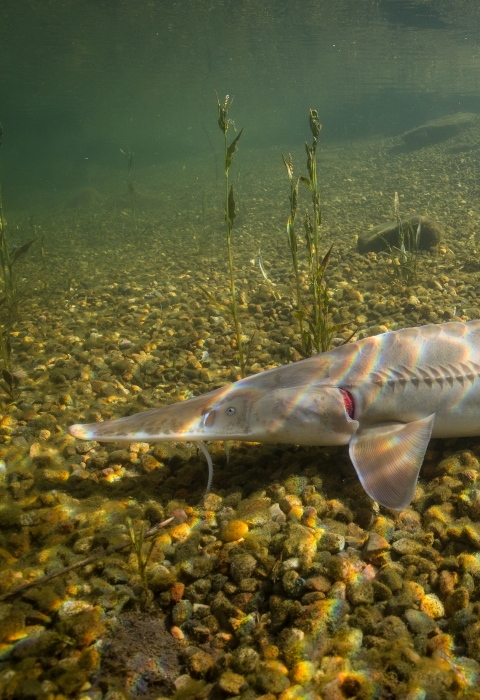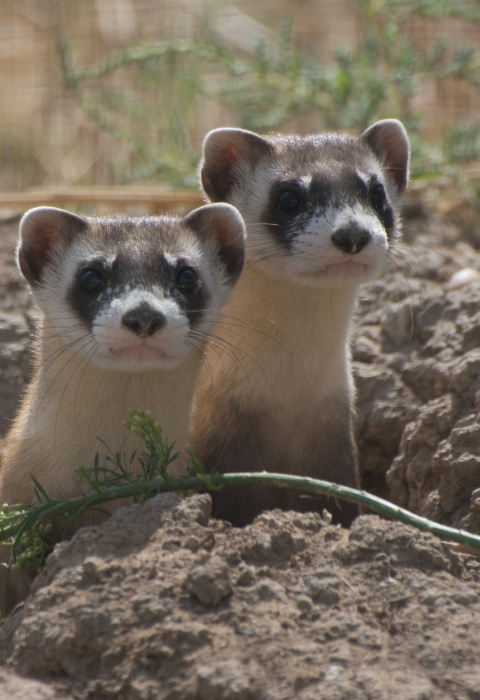Featured Species
The U.S. Fish & Wildlife Service (Service) is responsible for implementing the Endangered Species Act to protect and recover listed species of plants and animals native to the United States and its territories. The Service consults on actions authorized, funded or carried out by other federal agencies to determine the impacts of an action on listed species. This includes coordination with federal, state, local and private entities in the preservation of listed species. The Service also works with other scientists to develop recovery plans in order to identify actions necessary to conserve listed species and increase their numbers.
| Common Name | Scientific Name | Status | Range-Montana |
|---|---|---|---|
| Black-footed Ferret | Mustela nigripes | E/XN | Prairie dog complexes; eastern Montana |
| Whooping Crane | Grus americana | E | Wetlands; migrant eastern Montana |
| Pallid Sturgeon | Scaphirhynchus albus | E | Bottom dwelling; Missouri, Yellowstone, Marias, Milk, Poplar, Powder, Tongue Rivers |
| White Sturgeon (Kootenai River population) | Acipenser transmontanus | E | Bottom dwelling; Kootenai River |
| Grizzly Bear | Ursus arctos horribilis | T | Alpine/subalpine coniferous forest; Western Montana |
| Piping Plover | Charadrius melodus | T/CH | Missouri and Yellowstone River sandbars, alkali beaches; northeastern Montana. Alkali lakes in Sheridan County; riverine and reservoir shoreline in Garfield, McCone, Phillips, Richland, Roosevelt and Valley counties |
| Ute Ladies'-tresses | Spiranthes diluvialis | T | River meander wetlands; Jefferson, Madison, Beaverhead, Gallatin, Broadwater counties |
| Bull trout (Columbia River basin and St. Mary - Belly River populations) | Salvelinus confluentus | T/CH | Clark Fork, Flathead, Kootenai, St. Mary and Belly river basins; cold water rivers & lakes. Portions of rivers, streams, lakes and reservoirs within Deer Lodge, Flathead, Glacier, Granite, Lake, Lewis and Clark, Lincoln, Mineral, Missoula, Powell, Ravalli, Sanders counties |
| Canada Lynx (contiguous U.S. population) | Lynx canadensis | T/CH | Western Montana Resident – core lynx habitat, montane spruce/fir forests; Transient – secondary/peripheral lynx habitat. Western Montana - montane spruce/fir forest |
| Spalding's Catchfly | Silene spaldingii | T | Upper Flathead River and Fisher River drainages; Tobacco Valley - open grasslands with rough fescue |
| Yellow-billed cuckoo (western population) | Coccyzus americanus | T | Population west of the Continental Divide; riparian riparian Definition of riparian habitat or riparian areas. Learn more about riparian areas with cottonwoods and willows |
| Red Knot | Calidris canutus rufa | T | Migrant; eastern Montana plains along shorelines |
| Northern Long-eared Bat | Myotis septentrionalis | E | Eastern Montana; caves, abandoned mines; roosts in live trees and snags |
| Meltwater Lednian Stonefly | Lednia tumana | T | High elevation meltwater streams; Glacier, Flathead, and Lake Counties |
| Western Glacier Stonefly | Zapada glacier | T | Typically found in clean, cold running waters that have high oxygen content. Glacier and Carbon Counties |
| Whitebark Pine | Pinus albicaulis | T | Western, central, and southwestern Montana, in forests at upper subalpine elevations and near treeline |
| Monarch Butterfly | Danaus plexippus | C | Open grasslands, foothills, valley bottoms, roadsides, pastures, and suburban areas with sufficient milkweed for breeding and/or sufficient nectar resources from flowers during breeding and migration |
- ENDANGERED (E) - Any species that is in danger of extinction throughout all or a significant portion of its range.
- THREATENED (T) - Any species that is likely to become an endangered species within the foreseeable future throughout all or a significant portion of its range.
- PROPOSED (P) – Any species of that is proposed in the Federal Register to be listed under section 4 of the Act.
- CANDIDATE (C) - Those taxa for which the Service has sufficient information on biological status and threats to propose to list them as threatened or endangered. We encourage their consideration in environmental planning and partnerships, however, none of the substantive or procedural provisions of the Act apply to candidate species.
- NON-ESSENTIAL EXPERIMENTAL POPULATION (XN) - A population of a listed species reintroduced into a specific area that receives more flexible management under the Act.
- CRITICAL HABITAT, PROPOSED CRITICAL HABITAT (CH, PCH) - The specific areas (i) within the geographic area occupied by a species, at the time it is listed, on which are found those physical or biological features (I) essential to conserve the species and (II) that may require special management considerations or protection; and (ii) specific areas outside the geographic area occupied by the species at the time it is listed upon determination that such areas are essential to conserve the species.

